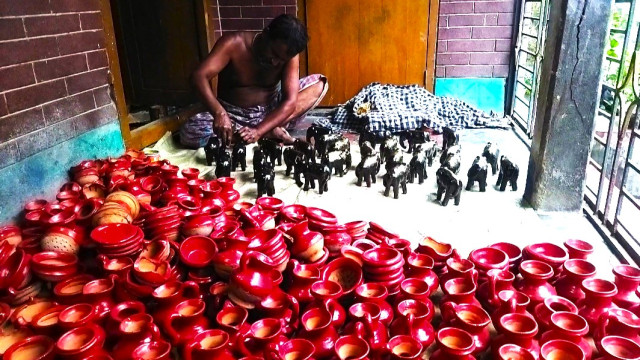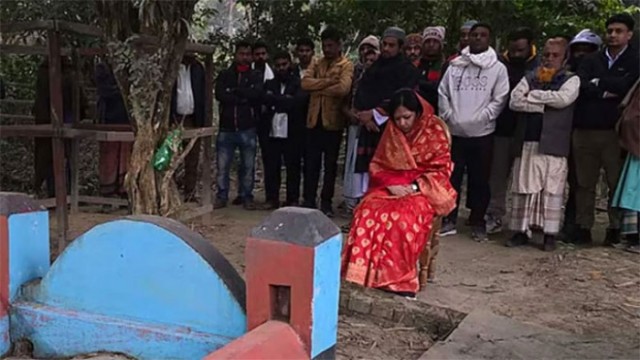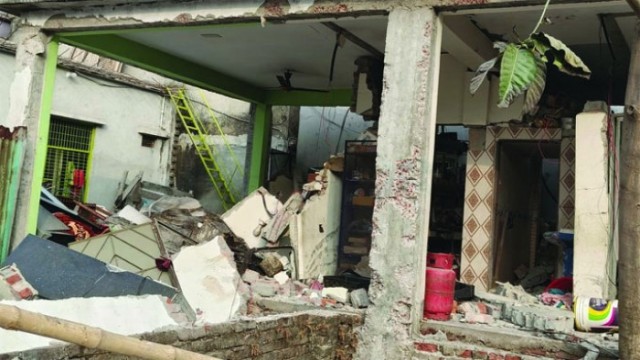Tangail, APR 13 (V7N)– In the lead-up to the Bengali New Year (Pohela Boishakh), a time when the vibrant culture of Bangladesh is celebrated, a somber reality faces the traditional potters of Tangail. Once bustling throughout the month of Chaitra crafting an array of attractive clay toys and ornaments for the festivities, these artisans are now witnessing their age-old craft fade away as plastic products increasingly dominate the market. The lack of demand for their traditional creations has forced many to abandon their ancestral profession, with those remaining heavily reliant on the production of yogurt pots for sustenance.
"With the Bengali festival of life, New Year, looming ahead, the potters of Tangail used to spend the entire month of Chaitra busy with work... However, that picture has completely changed now. Plastic has taken over the place of these products in the market. Due to lack of demand, these pottery crafts are disappearing one after another. Meanwhile, as the value of clay toys has decreased, they now rely heavily on yogurt pots," reported a Tangail Correspondent.
The art of pottery, deeply intertwined with the history, tradition, and culture of Bangladesh, is facing an existential threat. Once both a necessity of daily life and an expression of artistic beauty, the demand for clay objects has dwindled significantly. Consequently, many potters are leaving their ancestral trade to seek alternative livelihoods.
"This art is disappearing day by day with the passage of time. Nowadays, the use of these clay objects has decreased. As a result, many artists are leaving this profession and engaging in other professions. Pottery is a unique form of history, tradition, and culture. On the one hand, it is a necessity of life, and on the other hand, it is an expression of aesthetics and painting. The profession must be kept alive through government and private initiatives," the report emphasized.
Despite the challenges, several hundred potter families in areas like North Betdoba, Kokdohara Union, Narandia Union, Balla Union, Nagbari Union, and Enayetpur in the Tangail Sadar Municipality area of Kalihati Upazila continue to uphold this traditional craft.
"Several hundred potter families still maintain this craft in North Betdoba, Kokdohara Union, Narandia Union, Balla Union, Nagbari Union, and Enayetpur in Tangail Sadar Municipality area of Kalihati Upazila of Tangail," the correspondent noted.
Concerned individuals believe that providing support to modernize the production of clay utensils could not only revive the pottery industry but also significantly reduce the environmental impact of plastic.
"Those concerned say that if support is provided to modernize clay utensils, the negative impact of plastic on the environment can be greatly reduced," the report highlighted.
Surveys indicate a significant decline in the number of potter families in the region. For instance, in Uttar Betdoba of Kalihati Upazila, over a hundred pottery-making families have left their ancestral homes, with only about 40 remaining. Similar declines have been observed in other areas.
"It has been found that 40 families still live in North Betdoba of Kalihati Municipality in Kalihati Upazila, 50 families in Kokdohara Union, about 100 families in Palima and Pathalia villages of Narandia Union, 90 families in Balla Pal Para of Balla Union, and 16 Kumar families in Ghonabari of Nagbari Union," the report detailed.
Mohan Pal, a potter from Kumarpara, shared the struggles faced by the community in preserving their ancestral profession. Surviving potters recall a time when they sold a wide range of clay products, including pots, pitchers, dolls, well pots, toys, and flower pots, in large quantities. However, with increasing modernization, the demand for these clay products has drastically diminished.
"Talking to Mohan Pal of Kumarpara, it is learnt that the potters are struggling to maintain the profession left by their ancestors. The potters who have survived in this industry say that the people of this community used to sell clay pots, pots, pitchers, dolls, well pots, toys, flower pots, clay banks, etc. in large quantities at the market or in villages... As the days go by, modernity is increasing. And as this modernity increases, the art products made of clay are disappearing," Pal explained.
Suresh Pal from Uttar Betdoba lamented the business slowdown, which has led to the migration of numerous potter families. He highlighted the rising costs of raw materials like clay, coupled with stagnant prices and low demand for their finished products, forcing many to rely on making and selling curd pots just to survive.
"Suresh Pal of Uttar Betdoba in Kalihati Upazila said, 'Due to the business slowdown, more than a hundred families who make pottery here have left their ancestral homes. About 400 families have gone to other professions. Now, only a handful of families are continuing this profession of their forefathers.' He added, 'We have to buy clay from different places. The prices of everything are increasing, but the prices of our clay products have not increased. Clay products are not sold, and if the prices are increased, people will not buy them. I somehow survive by selling curd pots,'" Pal shared.
Elderly potters like Muntu Pal (82) and Khushimohan Pal (71) from Badda Pal Para in Kokdahara Union, who have dedicated their lives to the craft, echoed these concerns. They pointed to the increased production costs due to the high prices of wood and clay and expressed doubts about the future of their profession without external support. However, they remain hopeful that government agencies like BSCIC (Bangladesh Small and Cottage Industries Corporation) could provide the necessary assistance for a revival.
"Muntu Pal (82) and Khushimohan Pal (71) of Badda Pal Para in Kokdahara Union said, 'I have been working in the clay making industry since I was young, 50 families in our area do this work... Currently, the cost of production has increased a lot due to the high price of wood and clay.' Their business is now under threat as the demand for clay products in the market has decreased. They themselves are doubtful about whether this profession will exist in the future. Still, they believe that if the government's BSCIC or any other organization cooperates, they will be able to turn around again," the elderly potters expressed.
Shahnaz Begum, Assistant General Manager of BSCIC Tangail District Branch, acknowledged the plight of the pottery industry, recognizing it as an old and traditional craft on the verge of extinction. She stated that while there were once 1,235 potters in the district, their numbers have dwindled significantly over time. Begum assured that if the potters seek cooperation from BSCIC, they would receive all possible support.
"In this regard, Shahnaz Begum, Assistant General Manager of BSCIC Tangail District Branch, said, 'Pottery is an old traditional industry of Bangladesh. Currently, it is on the verge of extinction. There were once 1,235 potters in different upazilas of the district. Due to the evolution of time, there are very few potters left now. If the potters ask for cooperation from us, we will provide them with all possible assistance,'" Begum affirmed.
The struggle of Tangail's potters highlights the broader challenges faced by traditional crafts in the face of modernization and the influx of cheaper, mass-produced alternatives like plastic. The potential loss of this unique art form would not only impact the livelihoods of these communities but also diminish a vital part of Bangladesh's cultural heritage.
END/BVT/RH/































Comment: